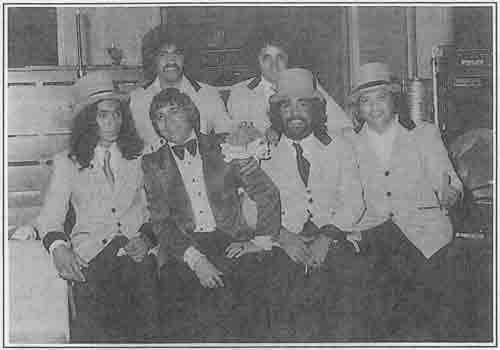Malcolm (Mac) was born in Kempsey, New South Wales in 1947. He lived on Burnt Bridge Mission until his family moved to Sydney in 1965.
Mac was a very talented musician and singer and upon arriving in Sydney he started performing at the Foundation for Aboriginal Affairs in George Street in the city. Mac’s band performed at the Foundation’s dances every Saturday and Sunday night.
In 1966 he formed the Silva Linings band in which he was singer and drummer. The band won the Gold Coast Battle of the Sounds. After several years the band changed its name to Black Lace.
Black Lace became very popular and gained a following throughout the Aboriginal communities in NSW and beyond. Blacks from everywhere would come to see Black Lace play, from Dubbo, Moreee and Northern NSW.

Black Lace at the National Aboriginal Day Ball, 1975
Back row: Arnold Williams, Frank
Front row: Andrew Donnelly, Cecil Patten, Kevin McGrady, Malcolm Silva
Mac had a way of making people feel welcome When he was playing he would greet people coming in the door. He showed no partiality to anyone regardless of their importance or standing in the community. He called all Kooris his brothers and sisters and he meant it. He was a great supporter of the Redfern All Blacks. Mac had a very gentle nature and would never row with anyone. Everyone loved him.
He used to sing the song Malabar Mansion which was written by a young Aboriginal man while in Long Bay Gaol. The song is about blackfellas in gaol and they say that it’s the most requested song on Radio Redfern. It is all about being in gaol and how sane men go mad when inside.
When the Black Theatre for the Arts folded, the building continued to be known as the Black Theatre. Sylvia Scott organised weekly dances at the Black Theatre for the young people of Redfern. Sylvia’s involvement with the Black Theatre started around 1977 while she was employed by the Aboriginal Children’s Service. These dances were held by different Aboriginal organisations and served a dual purpose of giving the young people something to do of an evening and raising money for the organisations, such as the Redfern All Blacks football team. Black Lace used to play at those Saturday night dances.
Mac passed away in April 1989 from a heart attack at the age of 42. His funeral was held at St Mary’s cathedral. The church which holds over a thousand was so full people stood in the park across the road. Mac was the first Aboriginal person to have a funeral service at St Mary’s Cathedral.
As singer in the band Black Lace Mac would always sing the song Put a candle in the window, the lyrics of which were ‘Put a candle in the window – I won’t be away too long and I’ll be coming back.’ It was thought this was a very apt song for the Mac Silva Centre, which opened in February1991. It was what the centre was all about, making a home for people and making them always feel welcome. This is why the logo for the centre contains the candle.